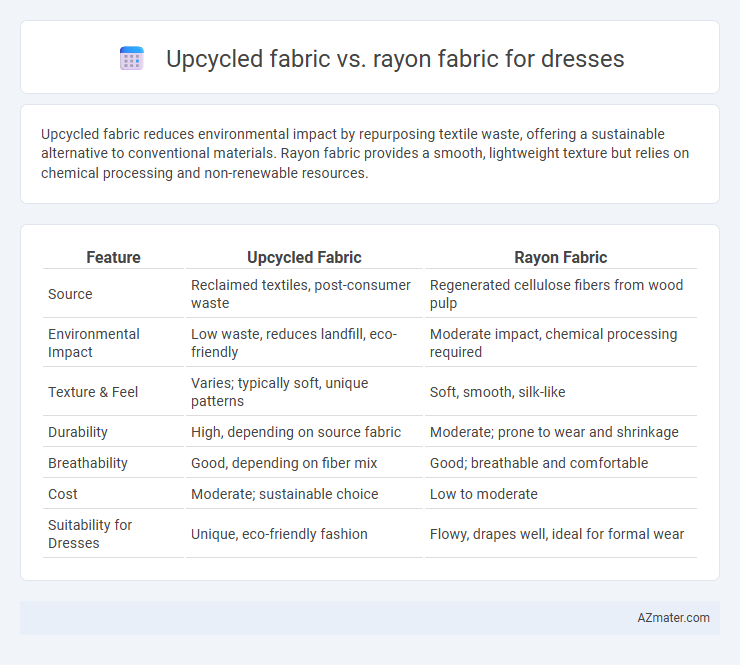Upcycled fabric reduces environmental impact by repurposing textile waste, offering a sustainable alternative to conventional materials. Rayon fabric provides a smooth, lightweight texture but relies on chemical processing and non-renewable resources.
Table of Comparison
| Feature | Upcycled Fabric | Rayon Fabric |
|---|---|---|
| Source | Reclaimed textiles, post-consumer waste | Regenerated cellulose fibers from wood pulp |
| Environmental Impact | Low waste, reduces landfill, eco-friendly | Moderate impact, chemical processing required |
| Texture & Feel | Varies; typically soft, unique patterns | Soft, smooth, silk-like |
| Durability | High, depending on source fabric | Moderate; prone to wear and shrinkage |
| Breathability | Good, depending on fiber mix | Good; breathable and comfortable |
| Cost | Moderate; sustainable choice | Low to moderate |
| Suitability for Dresses | Unique, eco-friendly fashion | Flowy, drapes well, ideal for formal wear |
Introduction to Upcycled and Rayon Fabrics
Upcycled fabric is created by repurposing discarded textiles, reducing waste and environmental impact while offering unique and sustainable material options for dresses. Rayon fabric, derived from natural cellulose fibers like wood pulp, provides a smooth, breathable, and affordable alternative with a silky texture ideal for lightweight garments. Understanding the source and production of upcycled and rayon fabrics helps in making eco-conscious and style-driven choices for dress manufacturing.
What is Upcycled Fabric?
Upcycled fabric is material repurposed from pre-existing textiles or garments, reducing waste and environmental impact compared to conventional fabric production. It offers a sustainable alternative by transforming discarded clothing or fabric scraps into new dress designs, minimizing resource consumption and landfill use. In contrast, rayon fabric is a semi-synthetic fiber derived from wood pulp through intensive chemical processing, which often involves higher energy and water use.
What is Rayon Fabric?
Rayon fabric, a semi-synthetic textile made from regenerated cellulose fibers derived from wood pulp, offers a smooth, breathable, and lightweight texture ideal for dresses. It mimics the feel of natural fibers like cotton or silk but tends to wrinkle easily and may require careful washing to maintain durability. Compared to upcycled fabric, rayon poses higher environmental concerns due to its chemical processing and resource-intensive production.
Environmental Impact: Upcycled vs Rayon
Upcycled fabric significantly reduces textile waste by repurposing pre-existing materials, thereby lowering the demand for virgin resources and minimizing landfill contributions. Rayon fabric production, however, involves extensive chemical processing and deforestation, leading to higher carbon emissions and water pollution. Choosing upcycled fabric for dresses supports sustainable fashion by conserving natural resources and reducing environmental degradation compared to conventional rayon manufacturing.
Fabric Durability and Longevity
Upcycled fabric offers superior durability due to its preservation of original textile fibers, often reinforced through careful repurposing techniques, making it ideal for long-lasting dresses. Rayon fabric, while soft and comfortable, tends to have lower tensile strength and is prone to weakening over time with repeated wear and washing. Choosing upcycled fabric enhances dress longevity by combining sustainable practices with durable material quality.
Comfort and Wearability Comparison
Upcycled fabric offers enhanced breathability and softness due to its natural fiber content, making it comfortable for prolonged wear in dresses. Rayon fabric, derived from cellulose fibers, provides a smooth, silky texture with excellent moisture absorption but can lose durability and shape after repeated washing. Both materials support comfortable wear, yet upcycled fabric often excels in sustainability and long-term comfort, while rayon is favored for its lightweight feel and drape.
Aesthetic Appeal and Versatility
Upcycled fabric offers a unique aesthetic appeal with its one-of-a-kind patterns and eco-conscious story, making each dress distinctly stylish and expressive. Rayon fabric provides a smooth, lustrous finish that mimics natural fibers like silk, enhancing dress versatility with its ability to drape elegantly for both casual and formal occasions. The choice between upcycled and rayon fabric impacts dress design by balancing individuality and sustainability against timeless softness and wearability.
Cost and Accessibility
Upcycled fabric for dresses offers a cost-effective and environmentally friendly option by repurposing existing materials, often resulting in lower prices compared to conventional fabrics. Rayon fabric, made from regenerated cellulose fibers, tends to be more widely accessible in retail stores but generally comes at a higher cost due to its manufacturing process and demand in fashion markets. Consumers seeking affordable and sustainable dress materials may prefer upcycled fabric, while those prioritizing smooth texture and availability might opt for rayon despite its relatively higher price.
Best Use Cases for Dresses
Upcycled fabric offers eco-friendly benefits and unique texture variations ideal for casual, bohemian-style dresses that emphasize sustainability and individuality. Rayon fabric provides a smooth, breathable, and drapey quality perfect for elegant, flowy dresses suited to formal and semi-formal occasions. Choosing between upcycled and rayon fabric depends on the dress's purpose, where upcycled fits sustainable fashion and rayon excels in comfort and classic silhouettes.
Final Verdict: Choosing Between Upcycled and Rayon Fabric
Upcycled fabric offers an eco-friendly choice by reducing waste and promoting sustainability, making it ideal for environmentally conscious dressmakers. Rayon fabric provides a smooth, breathable texture with vibrant colors but involves chemical processing that impacts the environment negatively. The final verdict depends on prioritizing sustainability and uniqueness with upcycled fabric or seeking affordable comfort and versatility with rayon for dress designs.

Infographic: Upcycled fabric vs Rayon fabric for Dress
 azmater.com
azmater.com